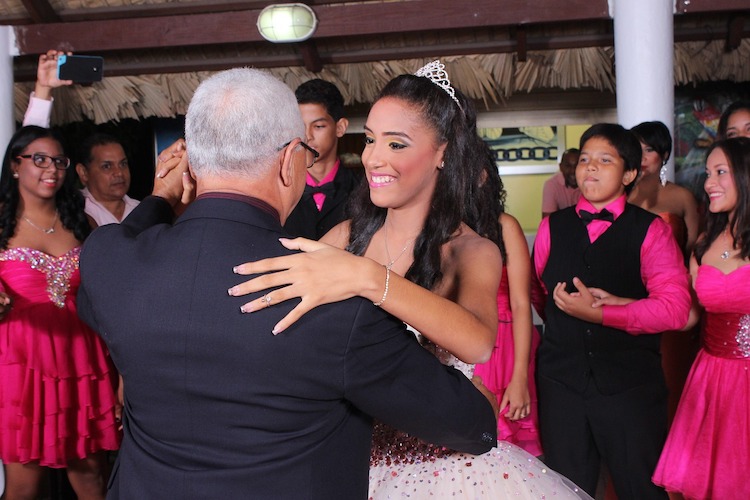Unforgettable Quinceañera Traditions
 In Mexico, a girl honoring her 15th birthday is celebrating her quinceañera. Throughout Latin America, it is quite common to hold a lavish extravaganza for this important milestone. Marking the girl’s coming of age and introduction to her mature stage of life, the quinceañera mirrors America’s common “Sweet Sixteen” tradition. Quinceañeras have become wildly popular throughout the United States with Latino families over recent years.
In Mexico, a girl honoring her 15th birthday is celebrating her quinceañera. Throughout Latin America, it is quite common to hold a lavish extravaganza for this important milestone. Marking the girl’s coming of age and introduction to her mature stage of life, the quinceañera mirrors America’s common “Sweet Sixteen” tradition. Quinceañeras have become wildly popular throughout the United States with Latino families over recent years.
Signifying the young woman’s transition into adulthood, a quinceañera celebration often includes exciting music, dancing, and lots of food. This celebration isn’t a new trend because the history of the quinceañera dates back to the 1500s.
Regarding the party aspect, it is customary for friends and family to volunteer to be padrinos or sponsors. Each of these sponsors takes financial and moral responsibility for the party. The birthday girl usually wears a ball gown with a petticoat underneath to portray a puffier look, as well as a tiara and gloves. In the U.S, the girl often wears a white dress; but, in other countries, mainly Mexico, she will often wear a pastel color, red, royal blue, or burgundy.
Timeless Quinceañera Traditions
Although traditions and customs for the quinceañera vary from family to family, there are a few consistent aspects across most celebrations. Here are a few traditions that you may want to include in your upcoming quinceañera celebration.
1) Mass & Fiesta
Traditional quinceañeras comprise of two parts: the Mass and the fiesta. Many celebrations begin with a special Mass that includes the girl’s parents, godparents, and court of honor (damas and chambelanes, usually 7 to 15 pairs of her friends). At the Mass, the girl receives Holy Communion and commits herself to God and the Virgin Mary. The birthday girl may also bring a flower bouquet or gifts to present to the Virgin Mary, given to the Church’s statue of Mary. Before the end of the Mass, the priest will bless the quinceañera.
After the Mass, the party begins with traditional dances and music, such as the monumental father-daughter dance and the group waltz. Some of these dances are very traditional and require preparation and practice. They usually start with a father and daughter waltz, followed by a dance with family and chambelanes. Also included in the fiesta may be gifts, dinner, cake, photos, and slide shows, home movies, and more for family and friends to enjoy together.
2) The Court
The birthday girl’s court first appears when they accompany her into the Church for Mass. The original tradition was to have a court of 14 boys (chambelanes) and 14 girls (damas), as well as a male escort for the birthday girl. The 15 couples symbolize each year of the girl’s life. But in modern times, it is quite common to see seven couples instead of 15. The dresses on the court should all be similar, and the boys should wear tuxes or other formal attire.
3) The Father-Daughter Dance
The first dance at the fiesta belongs to the birthday girl and her father. Traditionally, her father picks a song that is meaningful to the two. This dance between the two represents the girl’s first public dance and is meant for her father to present her to the guests. It also represents her father as the first man in her life. Once the song ends, the father may then hand his daughter over to her escort.
4) Changing of the Shoes
This tradition calls for the birthday girl to wear flats during the ceremony. In this ritual, one of her parents will take off the girl’s flats and replace them with elegant high-heels. This represents the girl’s first pair of heels, symbolizing her growth into womanhood and maturity.
5) The Candle Lighting Ceremony
The candle-lighting ceremony is a moving part of the celebration. The birthday girl takes time to honor instrumental loved ones in her life. There should be one candle lighter for each candle. It is common for each member of the court to light a candle and for the girl’s parents to light either the first or last one. Instead of the court doing so, the girl may choose fifteen people with whom she has a close relationship to light these candles.
6) Symbolic Gifts
One traditional gift that the girl may receive is the “last doll.” Usually, a porcelain doll dressed like the girl on the quinceañera, the gift signifies her passage from childhood into adulthood.
Other traditional gifts are a Bible, a rosary, a cross, or a medal. These religious gifts are often given during the Mass. Another gift given during the Mass could be 15 red roses from the girl’s grandparents. Each stem signifies strength, and each petal displays sweetness.
The family may also decide to give the girl a tiara or crown to signify responsibility. In many cultures, the birthday girl will receive a birthstone ring or bracelet to represent femininity and coming of age.
7) The Crowning Ceremony
During the party, the birthday girl gets the royal treatment when she receives a crown and scepter. The crown symbolizes that she is a princess in the eyes of God. The scepter represents her acceptance of the responsibilities of becoming a woman. Traditionally, the parents or godparents will present the birthday girl with these gifts.
Combine Tradition & Elegance for an Unforgettable Quinceañera
A memorable quinceañera celebration should incorporate aspects of traditional Hispanic customs and modern elements. Marking such an important transition in the young girl’s life, you’ll want to deliver the quinceañera she’s dreamt of for years.
With the fancy dress, extravagant decorations, gift preparation, and more, a magnificent quinceañera takes lots of planning. With assistance from the event planning experts at Knowles Hospitality, let’s work together to create an unforgettable quinceañera holding traditional and modern elements that suit your birthday girl the best.



